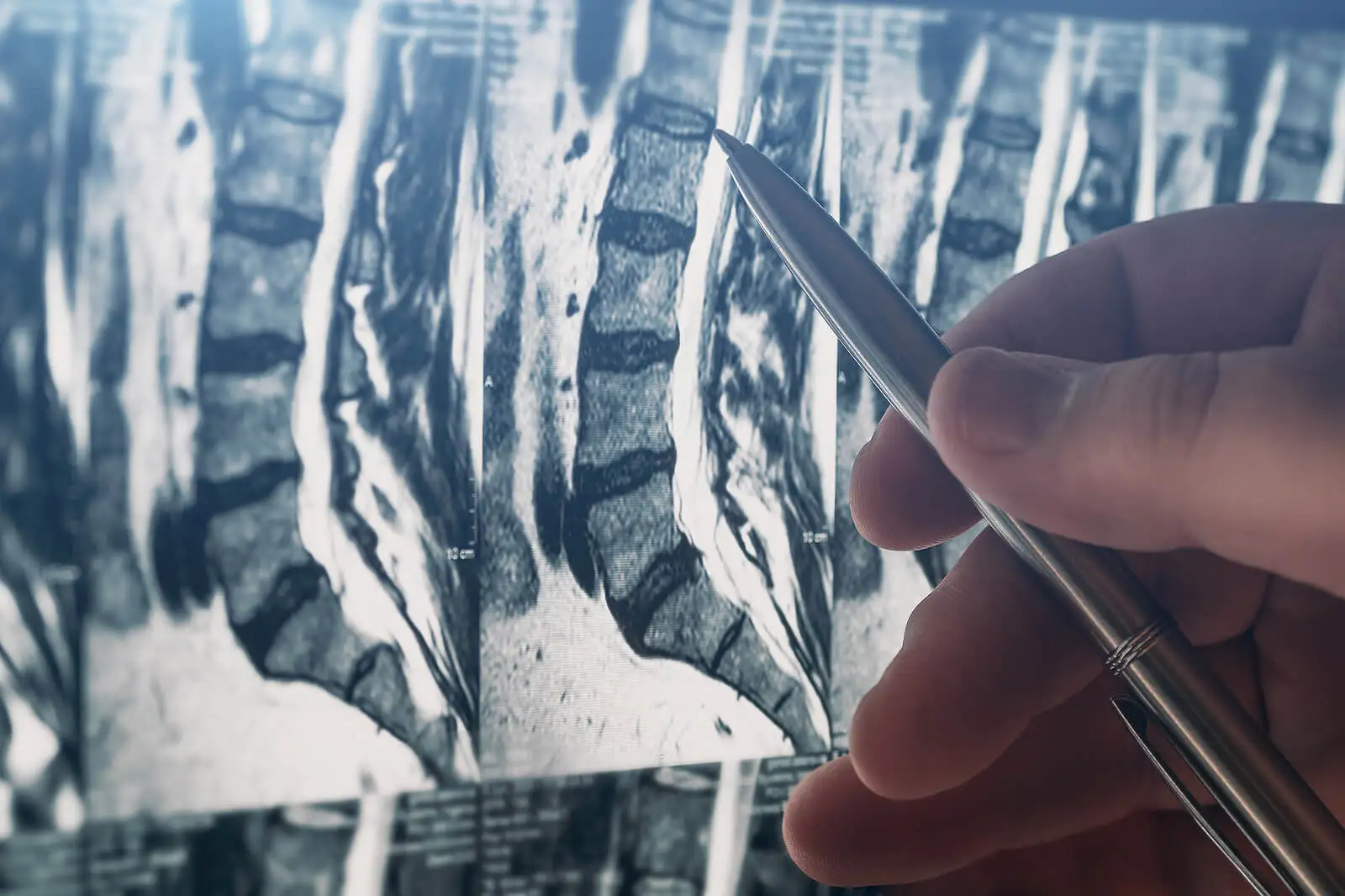Sacroiliitis: Causes, Symptoms and Treatment

Low back pain is a common cause of medical consultation worldwide. The origins of low back pain are very varied and range from conditions in the internal organs to problems in the bones and joints. Here we bring you everything you need to know about sacroiliitis.
When we talk about sacroiliitis, we’re referring to the inflammation of the sacroiliac joint. There are two such joints and they’re located in the lowest part of the back.
They’re responsible for joining the sacrum of the spine with the iliac bones of the pelvis on each side. Their function is to counteract the pressure of the legs during movement and the load of the body when standing.
This inflammatory process not only involves the structures located in the joint, but also affects the ligaments, muscles and nerves that are around it. The causes are multiple and are associated with an excessive overloading of the joint.
Symptoms of sacroiliitis
Currently, different research estimates a prevalence of sacroiliitis ranging from 23% to 63%, and it’s more frequent in older adults. In general, it affects one of the sacroiliac joints, with discomfort on the right side in 45% of cases and on the left side in 35%.
Involvement on both sides occurs in up to 20% of people.
Sacroiliitis usually appears as a continuous, localized, and persistent pain in the lower back. It may extend to the buttocks, groin, and the back of one or both legs, without reaching the knees. It’s described as an oppressive, dull, and burning sensation.
Similarly, this discomfort is often intensified by prolonged standing, climbing stairs, running, and walking on uneven surfaces. It decreases when sitting, but, in advanced cases, the pain appears even at rest.
The discomfort occurs in the early morning hours, accompanied by lumbar tension and joint stiffness. Generally, morning stiffness in sacroiliitis decreases throughout the day with movement.

Causes
Physical overload and repetitive forces of compression and traction on the joint apparatus are the main causes of sacroiliitis, according to scientific studies. Ligament, bone, and cartilage involvement promotes the release of chemicals that stimulate pain receptors.
Among the most common causes are the following:
- Osteoarthritis
- Repetitive trauma
- Ankylosing spondylitis
- Dysmetria between the legs
- Joint infections
- Sacral bone deformity
- Falls and car accidents
- Weakness of abdominal and gluteal muscles
On the other hand, during pregnancy, there are changes in the woman’s body that can cause sacroiliitis. This is the result of the relaxation of the ligaments that stabilize the joint, added to weight gain, and an altered gait.
You may be interested in: 3 Natural Remedies to Treat Low Back Pain
Risk factors
Sacroiliac inflammation is more common in older men. The following conditions increase the risk:
- Bad posture
- Overweight or obesity
- Carrying heavy objects
- Previous fractures and dislocations
- Alterations in spinal alignment, such as hyperlordosis and scoliosis
How is it diagnosed?
In most cases, the diagnosis is made by clinical assessment by a health care professional. The physician will ask about the onset of symptoms, how it appears, and the situations that trigger the pain. During the physical examination, the lower back will be inspected and touched.
It’s usual for the specialist to assess the muscle strength and mobility of the lumbar and sacral spine. In addition, different tests may be applied, such as the Gaenslen and Patrick test.
On the other hand, additional studies and imaging tests may be indicated to confirm the diagnosis. X-rays and MRIs of the pelvis and spine usually provide useful data on joint involvement. Similarly, the injection of anesthetics with a positive response can identify the origin.

Treatment of sacroiliitis
The treatment plan for sacroiliitis depends on the underlying cause and the severity of symptoms. In mild cases, the physician usually prescribes the use of analgesics, muscle relaxants, and nonsteroidal anti-inflammatory drugs (NSAIDs). In addition, belt orthoses can support pelvic alignment and stabilize the joint.
Physical therapy plays a key role in the management of sacroiliitis. It offers movement and stretching exercises that strengthen, stabilize, and improve flexibility.
Other recommendations include relative rest, avoiding overexertion, and the application of alternating hot and cold therapy.
If discomfort persists, intra-articular corticosteroid injections may be performed to relieve pain and reduce inflammation. In severe cases, surgical correction is necessary with the following procedures:
- Arthrodesis: The sacroiliac joint is permanently joined with titanium rods.
- Radiofrequency denervation: The nerve pathways that transmit pain are eliminated.
- Electrical stimulator implantation: A device is attached to the sacrum that reduces pain transmission.
Read more here: The Best and Most Effective Physiotherapy Treatments
Is it possible to prevent sacroiliitis?
Sacroiliitis is a fairly common painful condition in older people. In general, it’s possible to slow down the onset of this condition and reduce the risk of developing it with some changes in our lifestyle:
- Maintaining a healthy weight
- Avoiding a sedentary lifestyle
- Performing stretching and low joint impact exercises
Similarly, it’s advisable to go for a consultation with a rheumatology specialist upon suspicion of sacroiliitis. Doctors are the only ones qualified to treat this disease and provide the best guidance.
All cited sources were thoroughly reviewed by our team to ensure their quality, reliability, currency, and validity. The bibliography of this article was considered reliable and of academic or scientific accuracy.
- Mejía G, Arias M, Valdez K, Carrillo S, et al. Dolor de la articulación sacroilíaca. Anatomía, Diagnóstico y Tratamiento. Rev. Soc. Esp. Dolor. 2008; 3 (1): 170-180.
- Marín J, Catay E, Bravo M, Navarta D, et al . Sacroileítis en pacientes con espondiloartritis: ¿qué rol juega la ecografía?. Rev. argent. reumatolg. 2016; 27( 2 ): 30-34.
- Solís JG, Flores-Padilla G. Sacroilitis paraneoplásica: presentación inusual de leucemia linfoblástica aguda. Cir Cir. 2020;88(Suppl 2):71-74.
- Bollow M, Loreck D, Banzer D, Brandt H, et al. Imaging diagnosis in suspected inflammatory rheumatoid axial skeleton diseases (sacroilitis). Z Rheumatol. 1999 Apr;58(2):61-70.
- Soto Quijano DA, Otero Loperena E. Sacroiliac Joint Interventions. Phys Med Rehabil Clin N Am. 2018 Feb;29(1):171-183.
- Alcobendas RM, Loza SM, Camba AR, Gascon CU, et al. Sacroilitis in Preschool Children: A Case Series and Review of the Literature. Pediatr Infect Dis J. 2020 Sep;39(9):e272-e274.
This text is provided for informational purposes only and does not replace consultation with a professional. If in doubt, consult your specialist.








